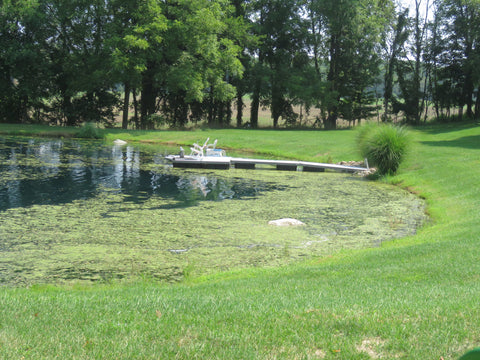Easy Tips to Stop Algae From Growing | Organic Pond
It’s not too early to gear up for Spring! During the winter there’s not much you need to do to care for your pond, especially if it’s frozen over. Once the weather starts getting warmer, that’s when you should be proactive to make sure your pond or lake looks beautiful for the rest of the year. A beautiful and healthy pond doesn’t happen magically. It requires monitoring and proactive maintenance to stay in great shape. Algae blooms are one of the most common problems pond owners are confronted with. Beyond the unsightly appearance, certain algae can even be toxic. This year you can be ready for any algae blooms.

You might think that simply removing algae found in your pond would solve your problems. While it is quick relief, mechanical removal of algae by raking, cutting, or screening is mostly ineffectual at harnessing its renewed growth. Algae spreads through shedding spores and through stem and leaf cuttings. Merely removing algae also fails to address the underlying conditions that gave the algae its momentum. It will simply grow back and, likely, spread in the process. There are three common factors that create a friendly environment for algae to thrive. Be alert to these so you can stay one step ahead of algae and stop it from ever starting to bloom in your waters.
1. Surface Run-Off/Nutrient Overload: Fertilizers, sewage, and contaminated soil can leach into your pond. This often causes levels of phosphorous and nitrogen levels to rise, which correspondingly increases the growth and prevalence of algae.
How can you make sure that this doesn’t affect your pond? You should use non-phosphorus fertilizer on your lawn or grass. Another important factor for managing algae growth in your pond is don’t allow grass and weed trimming clippings to enter your pond via mechanical discharge or blowing. If they do happen to float into your pond, try your best to scoop them out.
2. Warm Water: Warm water spurs algae growth and can be very tough to control. Water temperature can become increased due to warm weather, excessive sunlight exposure, and even floating or suspended sediments in the water column.
One of the best ways to combat rising water temperatures is the use of safe, food-grade pond dyes. These will help reduce the sunlight penetration into your pond or lake. The reduction of sunlight coming into the body of water helps lower the water’s temperature by limiting UV penetration and, thus, inhibiting photosynthesis. This translates into less organic growth of weeds and/or algae. Organic Pond's Food-Grade Pond Dye blocks UV rays, cools the water, and reduces organic growth - while showcasing the natural beauty of your pond.

3. Lack of Water Motion: Stagnant water creates an ideal condition for oxygen depletion and algae growth. Oxygen depletion can occur due to overabundant organic decay (which consumes oxygen) or through seasonal temperature fluctuations, such as when summer temps cause the water column to stratify. It is especially harmful to fish when the top layer of water becomes warmer, less dense, and less oxygenated.
Adding an aeration pump to your pond is a great solution to increase water motion. Aerators pump diffused air from the bottom of your pond up to the surface, pushing air through the decaying organic matter where it is most concentrated and stagnant. Browse a great line of Vertex Aerators for ponds and large lakes from Organic Pond’s newly designed website.

Finally, regularly treat your pond for algae bloom prevention with beneficial bacteria. Careful use of naturally occurring, non-pathogenic beneficial bacteria provides a fast-acting extra dose of the healthy bacteria already existing in your pond.
They’re called beneficial because they are very efficient at consuming excess, undesired nutrients in your pond’s water column and they speed the decay of organic sludgy muck from the bottom of your pond. These micro-organisms work best not as a one-time boost, but when used regularly, often monthly. Organic Pond’s Beneficial Bacteria Products are safe for humans, fish, and wildlife. They carry no water usage restrictions. When used in conjunction with dye, its effects are more sustainable. Start applying when water temps are 40 degrees or higher.
Be proactive about algae and your pond or lake will look beautiful for the rest of the year. And, if you’re not sure what’s causing your pond issues, the experts at Organic Pond are ready to help with a no-obligation diagnosis and advice!
Let us assess your algae and weed control problems or provide more information about diffused aeration systems.
We don’t want you to waste time and effort on the wrong treatment - we want you to be successful! Send an image of your pond problem to jim@organicpond.com or call (888) 986-9995 Mon - Fri, 10am - 5pm EST.
This year, gear up for Spring and be ready for any algae blooms!
